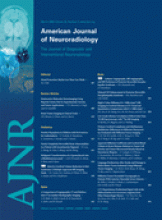Research ArticleBrain
A T1 Hyperintense Perilesional Signal Aids in the Differentiation of a Cavernous Angioma from Other Hemorrhagic Masses
T.J. Yun, D.G. Na, B.J. Kwon, H.G. Rho, S.-H. Park, Y.-L. Suh and K.-H. Chang
American Journal of Neuroradiology March 2008, 29 (3) 494-500; DOI: https://doi.org/10.3174/ajnr.A0847
T.J. Yun
D.G. Na
B.J. Kwon
H.G. Rho
S.-H. Park
Y.-L. Suh

References
- ↵Zabramski JM, Wascher TM, Spetzler RF, et al. The natural history of familial cavernous malformations: results of an ongoing study. J Neurosurg 1994;80:422–32
- ↵Rigamonti D, Drayer BP, Johnson PC, et al. The MRI appearance of cavernous malformations (angiomas). J Neurosurg 1987;67:518–24
- ↵
- Moran NF, Fish DR, Kitchen N, et al. Supratentorial cavernous haemangiomas and epilepsy: a review of the literature and case series. J Neurol Neurosurg Psychiatry 1999;66:561–68
- ↵Sandalcioglu IE, Wiedemayer H, Secer S, et al. Surgical removal of brain stem cavernous malformations: surgical indications, technical considerations, and results. J Neurol Neurosurg Psychiatry 2002;72:351–55
- ↵Rapacki TF, Brantley MJ, Furlow TW Jr, et al. Heterogeneity of cerebral cavernous hemangiomas diagnosed by MR imaging. J Comput Assist Tomogr 1990;14:18–25
- ↵Gomori JM, Grossman RI, Goldberg HI, et al. Occult cerebral vascular malformations: high-field MR imaging. Radiology 1986;158:707–13
- ↵Tomlinson FH, Houser OW, Scheithauer BW, et al. Angiographically occult vascular malformations: a correlative study of features on magnetic resonance imaging and histological examination. Neurosurgery 1994;34:792–99
- ↵Gelal F, Feran H, Rezanko T, et al. Giant cavernous angioma of the temporal lobe: a case report and review of the literature. Acta Radiol 2005;46:310–13
- ↵
- Duong H, del Carpio-O'Donovan R, Pike B, et al. Multiple intracerebral cavernous angiomas. Can Assoc Radiol J 1991;42:329–34
- Rosso D, Lee DH, Ferguson GG, et al. Dural cavernous angioma: a preoperative diagnostic challenge. Can J Neurol Sci 2003;30:272–77
- House P, Dunn J, Carroll K, et al. Seeding of a cavernous angioma with mycoplasma hominis: case report. Neurosurgery 2003;53:749–52
- Jabbour P, Gault J, Murk SE, et al. Multiple spinal cavernous malformations with atypical phenotype after prior irradiation: case report. Neurosurgery 2004;55:1431
- Arismendi Morillo GJ, Fernandez Abreu MC, Cardozo Sosa DP, et al. Nonneoplastic space occupying lesions mimicking central nervous system tumors. Rev Neurol 2004;38:427–30
- Harada S, Niimi M, Murakami K, et al. Cavernous angioma of the corpus callosum mimicking an astrocytic tumor–case report. Neurol Med Chir 2001;41:349–51
- ↵Chicani CF, Miller NR, Tamargo RJ. Giant cavernous malformation of the occipital lobe. J Neuroophthalmol 2003;23:151–53
- ↵Sage MR, Brophy BP, Sweeney C, et al. Cavernous haemangiomas (angiomas) of the brain: clinically significant lesions. Australas Radiol 1993;37:147–55
- ↵Sato K, Kubota T. Large calcified cystic cavernous angioma in the thalamus–case report. Neurol Med Chir 1995;35:100–03
- ↵
- ↵
- ↵Gottfried ON, Gluf WM, Schmidt MH. Cavernous hemangioma of the skull presenting with subdural hematoma. Case report. Neurosurg Focus 2004;17:ECP1
- ↵Landis JR, Koch GG. The measurement of observer agreement for categorical data. Biometrics 1977;33:159–74
- ↵
- ↵Betz AL, Iannotti F, Hoff JT. Brain edema: a classification based on blood-brain barrier integrity. Cereb Brain Metab Rev 1989;1:133–54
- ↵Wagner KR, Xi G, Hua Y, et al. Lobar intracerebral hemorrhage model in pigs: rapid edema development in perihematomal white matter. Stroke 1996;27:490–97
- ↵Xi G, Wagner KR, Keep RF, et al. The role of blood clot formation on early edema development following experimental intracerebral hemorrhage. Stroke 1998;29:2580–86
- ↵Huang FP, Xi G, Keep RF, et al. Brain edema after experimental intracerebral hemorrhage: role of hemoglobin degradation products. J Neurosurg 2002;96:287–93
- ↵Xi G, Hua Y, Bhasin RR, et al. Mechanisms of edema formation after intracerebral hemorrhage: effects of extravasated red blood cells on blood flow and blood-brain barrier integrity. Stroke 2001;32:2932–38
- ↵Papadopoulos MC, Saadoun S, Binder DK, et al. Molecular mechanisms of brain tumor edema. Neuroscience 2004;129:1011–20
- Kaal EC, Vecht CJ. The management of brain edema in brain tumors. Brain and nervous system. Curr Opin Oncol 2004;16:593–600
- ↵
- ↵Maraire JN, Awad IA. Intracranial cavernous malformations: lesion behavior and management strategies. Neurosurgery 1995;37:591–605
- ↵Clatterbuck RE, Eberhart CG, Crain BJ, et al. Ultrastructural and immunocytochemical evidence that an incompetent blood-brain barrier is related to the pathophysiology of cavernous malformations. J Neurol Neurosurg Psychiatry 2001;71:188–92
- ↵Tu J, Stoodley MA, Morgan MK, et al. Ultrastructural characteristics of hemorrhagic, nonhemorrhagic, and recurrent cavernous malformations. J Neurosurg 2005;103:903–09
- ↵Wong JH, Awad IA, Kim JH. Ultrastructural pathological features of cerebrovascular malformations: a preliminary report. Neurosurgery 2000;46:1454–59
In this issue
Advertisement
T.J. Yun, D.G. Na, B.J. Kwon, H.G. Rho, S.-H. Park, Y.-L. Suh, K.-H. Chang
A T1 Hyperintense Perilesional Signal Aids in the Differentiation of a Cavernous Angioma from Other Hemorrhagic Masses
American Journal of Neuroradiology Mar 2008, 29 (3) 494-500; DOI: 10.3174/ajnr.A0847
0 Responses
Jump to section
Related Articles
- No related articles found.
Cited By...
This article has been cited by the following articles in journals that are participating in Crossref Cited-by Linking.
- Sachin Batra, Doris Lin, Pablo F. Recinos, Jun Zhang, Daniele RigamontiNature Reviews Neurology 2009 5 12
- Daniel T. Ginat, Steven P. MeyersRadioGraphics 2012 32 2
- David A. Cousins, Benjamin Aribisala, I. Nicol Ferrier, Andrew M. BlamireBiological Psychiatry 2013 73 7
- Kevin Y. Wang, Oluwatoyin R. Idowu, Doris D.M. Lin2017 143
- Michiel Poorthuis, Neshika Samarasekera, Krystle Kontoh, Ian Stuart, Buddug Cope, Neil Kitchen, Rustam Al-Shahi SalmanActa Neurochirurgica 2013 155 4
- Danila Kuroedov, Bruno Cunha, Jaime Pamplona, Mauricio Castillo, Joana RamalhoJournal of Neuroimaging 2023 33 2
- J.J. Cortés Vela, L. Concepción Aramendía, F. Ballenilla Marco, J.I. Gallego León, J. González-Spínola San GilRadiología 2012 54 5
- Burce Ozgen, Efsun Senocak, Kader K. Oguz, Figen Soylemezoglu, Nejat AkalanNeuroradiology 2011 53 4
- Baseline and Evolutionary Radiologic Features in Sporadic, Hemorrhagic Brain Cavernous MalformationsK.D. Flemming, S. Kumar, G. Lanzino, W. BrinjikjiAmerican Journal of Neuroradiology 2019 40 6
- Xiaodi Li, Yuzhou Wang, Wenming Chen, Wensheng Wang, Kaizhe Chen, Huayin Liao, Jianjun Lu, Zhigang LiJournal of Clinical Neuroscience 2016 26
More in this TOC Section
Similar Articles
Advertisement











